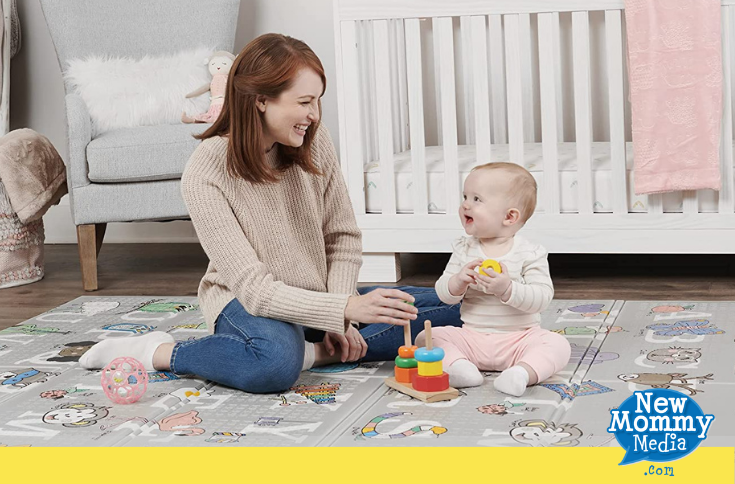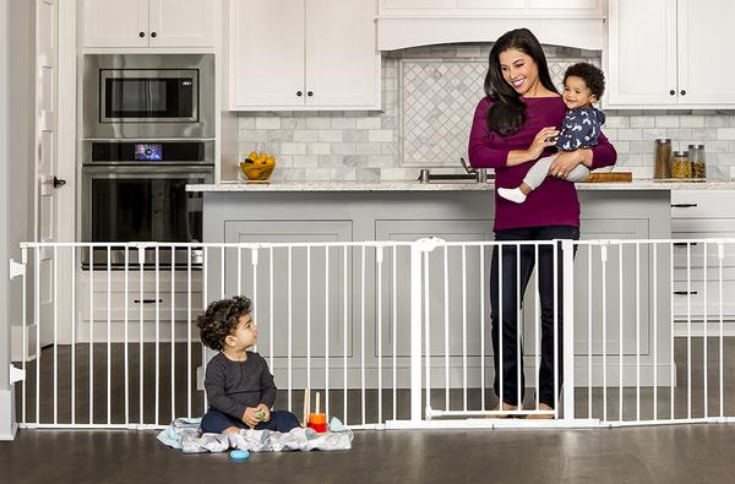How to Create a Safe Play Space for Baby
In this article:
- Why is having a safe space important?
- When should you build a safe space?
- How should the space look and feel?
- Where should the safe space be?
- How do you make this space practical?

Creating a safe play space for a baby is more important than you may think. It’s almost as essential for the baby as it is for the mother. Having a safe play space for a baby gives us moms a bit more time on our hands, without having to worry about the baby’s safety every 5 seconds. Every mom learns to value peace and quiet a bit more, the deeper we go into motherhood. As a new mom, in particular, you quickly realize that peace and quiet can simply mean just having a quick shower, a balanced meal or a full night’s rest. By creating a safe play space for your baby at home, you’ll be a step closer to having more peace and quiet mentally and physically.
In order to create a safe play space for your baby, there are a few fundamentals that need to be established first.
Create A Safe Space for Mommy-And-Me Time
The safe play space that you create for your baby is usually where your baby will spend most of their awake time while at home. With this in mind, the play space should feel more liberating than restrictive, for both you and your baby. It should feel like a space where you can also relax and play freely with your baby. You’ll ultimately need to find a delicate balance between encouraging independent play from your baby while also finding time to play with your baby in the space, so that they don’t associate it with being left alone.
TIP: Need some help creating your safe space? Regalo Baby specializes in baby safety products from the newborn stage through the toddler years. Visit this link and get 25% off plus FREE shipping. Use our special promo code, MOMMY.
One way to encourage independent play is by allowing your child to take the lead in play, while you observe and respond to their cues for appreciation and affection. One way to help your baby associate their play space with warmth, fun and engagement – even if they are alone – is to build out the space early on. This will help them grow into the space until it becomes familiar for them. A great tip is to also build out the space up to a toddler level from the very beginning – since children tend to do things sooner than we expect most times. So your baby will be constantly challenged, engaged and more importantly, busy!
Build A Safe Space In Plain Sight
When creating a safe play space for your baby, the physical location is top priority. You’d want to position it somewhere that’s in plain sight of at least two places where you’d spend most of your day. So perhaps choose between the living room, bedroom and the kitchen. Building it too close to the kitchen would, of course, be a hazard, but at least having it in plain sight of the kitchen is a good idea.
If you’re able to accommodate a room entirely for your baby’s play space, then that’s great! If not, all things are still possible with creativity, Pinterest and the right products. If you need to use a room that has dual purpose – like a living room – as long as things can be moved around without much hassle, then you’ll be set in no time. Natural lighting would be great to have streaming through the room to help keep your baby’s circadian rhythm in line.
It’s important to look at things from a toddler’s view and lay flat in the space and simply observe the surroundings. You may find tiny objects like staples within reach or see that furniture and fixtures need to be moved away more, so that your baby or toddler doesn’t attempt a great escape adventure!
Create A Practical Space
When all is said and done, your baby should actually want to stay in this safe play space that you’ve worked so hard to create for them. That’s the whole point, right? So how should you actually fill this space, practically? Here are a few items to have in the safe play space as a bare minimum.
Play Mat
A play mat is a great way to help moms ensure those tiny hands and feet are protected from hard surfaces. It’s also a simple way to incorporate stimulation from colors, letters, numbers and other engaging objects. When deciding on a play mat, choose one that is soft, but firm, durable (against sharp tiny nails!), can be easily stored away, is lightweight and can grow with your baby. My Regalo Play Mat checks all these boxes and has the added bonus of being reversible. So it’s twice the fun!
Baby Fence
A baby fence offers the physical protection you need by securing your child within the safe play space you created. Some baby gates can also double as baby fences and may be more convenient to purchase as a 2-in-1, depending on your budget.
Age-appropriate Toys
A quick rule of thumb for age-appropriate toys for babies is that once it can fit through the toilet roll center, it’s more than likely a choking hazard for your baby. Since babies put almost everything in their mouths, size plays a big role in age-appropriateness.
Get ready to watch your baby play with a piece of cardboard over that expensive electronic toy that you got for their cognitive development. At the end of the day, your child’s review is the best review, so choose toys that your baby responds well to, rather than those that simply have impressive buyer ratings.
Baby-proofed Room
Outside of the safe space you create for your baby, it’s also important to baby-proof the space that surrounds the safe space. Plug covers, edge guards and door stoppers are usually top of the list to help improve the safety of the entire space outside the baby’s play space. Ultimately, it’d be great if the entire house is baby-proofed, but baby-proofing the baby’s play space is a great start to overall safety.
